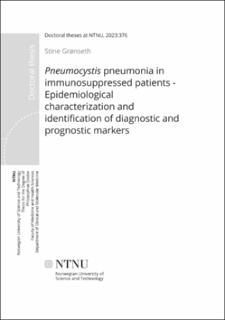| dc.contributor.advisor | Damås, Jan Kristian | |
| dc.contributor.advisor | Afset, Jan Egil | |
| dc.contributor.author | Grønseth, Stine | |
| dc.date.accessioned | 2023-11-13T10:20:51Z | |
| dc.date.available | 2023-11-13T10:20:51Z | |
| dc.date.issued | 2023 | |
| dc.identifier.isbn | 978-82-326-7451-0 | |
| dc.identifier.issn | 2703-8084 | |
| dc.identifier.uri | https://hdl.handle.net/11250/3102130 | |
| dc.description.abstract | Background
Pneumocystis jirovecii is an opportunistic fungus and the causative agent of Pneumocystis pneumonia (PCP) in humans. PCP is foremost known as an AIDS-defining illness in people with advanced HIV-infection. However, with the advent of highly active antiretroviral therapy this disease burden is declining in industrialized countries with universal health care. In contrast, we observe an increasing incidence of non-HIV PCP owing to longer survival and more aggressive therapies applied to cancers, immunological disorders, solid organ transplantation, and chronic lung diseases. PCP can be life-threatening. Prompt diagnosis and initiation of antimicrobial treatment improve survival but are challenged by unspecific clinical presentation and manifestations. Chemoprophylaxis to high-risk individuals is both safe and cost-effective. The overall aim of this Ph.D.-project was to investigate the burden of PCP in a Norwegian healthcare setting and identify diagnostic and prognostics predictors for PCP.
Methods
All three papers in this thesis are based on review of electronic hospital records. We included adults with positive P. jirovecii PCR in a respiratory specimen between 2006 and 2017 at St. Olavs hospital, Trondheim University Hospital, the only tertiary referral center in Central Norway. Inclusion of survivors required active consents. We collected comprehensive clinical and epidemiological characteristics and registered de-identified data in a tailored electronic form. Next, we used statistic methods to analyze the data. In the first study, we described the patient population, their clinical course, and epidemiological trends. In the second study, we assessed the in-house semiquantitative real-time PCR’s ability to differentiate between PCP and colonization in HIV-negative patients. In the third study, we identified factors associated with 30-day mortality in HIV-negative patients with proven or probable PCP.
Results
In the first study we included 296 patients from Central Norway Health Authority with positive P. jirovecii between 2006 and 2017. All but six patients had non-HIV underlying conditions. Cancers combined accounted for 61.5 %, followed by immunological disorders, solid organ transplantations, and chronic lung diseases. Premorbid exposure to systemic corticosteroids alone or in combination with other therapies was a common denominator in 12 73.5 %. Only three patients were receiving chemoprophylaxis at presentation. The majority presented with at least two cardinal symptoms whereas hypoxia, cytopenias, and radiological manifestations compatible with PCP constituted the main objective findings. In-hospital mortality was 21.6 % (n = 64/296). We found an annual increase in both the number of PCR tests performed and positive cases from the introduction of PCR in 2006 to 2017. In the second study, the in-house PCR assay showed a sensitivity of 71.3 % and a specificity 77.1 % for distinction between non-HIV PCP and colonization. Stratification according to underlying condition improved the discrimination, likely due to intrinsic and extrinsic host heterogeneity within non-HIV PCP. In the third study, we found that high fungal burdens, indicated by low cycle threshold-values from semiquantitative real-time PCR in bronchoalveolar lavage-fluid, were independently associated with higher 30-day mortality. The risk of dying was especially high in those with high degree of multimorbidity in addition to high fungal burdens. Comorbid cardiovascular disease, solid tumors, immunological disorders, premorbid corticosteroids, severe hypoxemia and inflammatory host response, low serum-albumin, and lymphopenia were also independently associated with 30-day mortality.
Conclusion
The incidence of PCP seems to be increasing in Norway in patients exposed to chemotherapy and immunosuppressants. The morbidity and mortality attributed to P. jirovecii is substantial. This evolution calls for strategies to increase awareness and administration of prophylaxis to reduce the disease burden. | en_US |
| dc.language.iso | eng | en_US |
| dc.publisher | NTNU | en_US |
| dc.relation.ispartofseries | Doctoral theses at NTNU;2023:376 | |
| dc.relation.haspart | Paper 1: Grønseth, Stine; Rogne, Tormod; Hannula, Raisa; Åsvold, Bjørn Olav; Afset, Jan Egil; Damås, Jan Kristian. Epidemiological and clinical characteristics of immunocompromised patients infected with Pneumocystis jirovecii in a twelve-year retrospective study from Norway. BMC Infectious Diseases 2021 ;Volum 21.(1) s. - © The Author(s). 2021 This is an open access article under the CC BY license. | en_US |
| dc.relation.haspart | Paper 2: Grønseth, Stine; Rogne, Tormod; Hannula, Raisa; Åsvold, Bjørn Olav; Afset, Jan Egil; Damås, Jan Kristian. Semiquantitative Real-Time PCR to Distinguish Pneumocystis Pneumonia from Colonization in a Heterogeneous Population of HIV-Negative Immunocompromised Patients. Microbiology spectrum 2021 ;Volum 9.(1) s. e0002621- Copyright © 2021 Grønseth et al. This is an open access article under the CC BY license. | en_US |
| dc.relation.haspart | Paper 3: Grønseth, Stine; Rogne, Tormod; Heggelund, Lars; Åsvold, Bjørn Olav; Afset, Jan Egil; Damås, Jan Kristian. Role of fungal burden in risk stratification of HIV-negative patients with Pneumocystis pneumonia: A 12-year, retrospective, observational, multicenter cohort. International Journal of Infectious Diseases 2023 ;Volum 134. s. 177-186. © 2023 The Author(s).This is an open access article under the CC BY license. | en_US |
| dc.title | Pneumocystis pneumonia in immunosuppressed patients - Epidemiological characterization and identification of diagnostic and prognostic markers | en_US |
| dc.type | Doctoral thesis | en_US |
